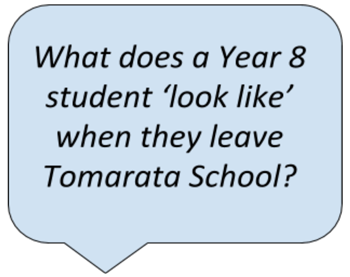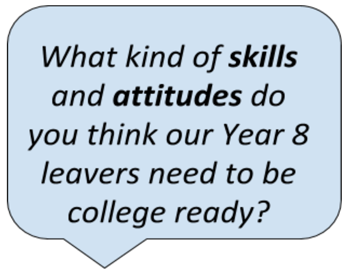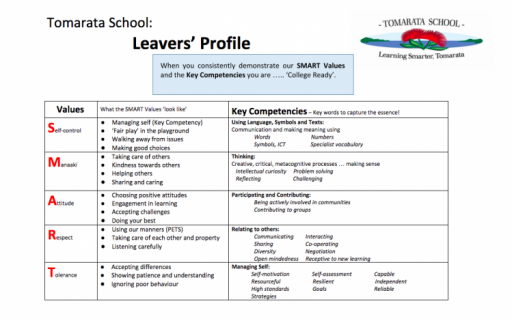Tomarata School is a rural primary school situated near Wellsford, north of Auckland, catering for students in years 1–8. Lynne Duffin, principal of Tomarata School, describes how her school community has created a leavers’ profile by exploring and defining what a future oriented learner looks like.
What is a leavers’ profile?
A leavers’ profile (also known as a graduate profile) describes skills, knowledge, and attitudes that students will need to develop in order to participate in a range of life contexts beyond school. Leavers’ profiles are often developed collaboratively by teachers, students, parents, whānau, and the wider community to communicate a collective vision for student learning.
Schools and communities are creating graduate profiles to share understandings of what a future oriented learner looks like. This led our school to pose the question:
Image: "What does a Year 8 student ‘look like’ when they leave Tomarata School?"
During 2017 we introduced the term "college ready" to support the transition for our school leavers as they prepare for secondary school. We believe that a fundamental goal for primary schools is to prepare students for high school, and that secondary schools need to focus on students being "career ready".
Learning pathways
A key goal for Tomarata School is to prepare their students for secondary school. They are working to design a local curriculum for their Year 7 and 8 learners that will ensure a positive transition to college with a clear sense of continuity and direction.
Purpose and process
We started the process of building a leavers’ profile by co-constructing an aspirational set of skills, attitudes, qualities, values, and understandings that students need to develop in order to participate effectively at secondary school.
Many schools incorporate the key competencies within their leavers’ profiles and use the following documents to support and guide their development:
- The New Zealand Curriculum (NZC)
- Te Marautanga o Aotearoa (the curriculum document that supports Māori medium levels 1 and 2)
- School curriculum and charters
- Existing systems and expectations, such as school values
We wanted our leavers’ profile to be:
- built collaboratively
- meaningful, clear, and concise
- personal to Tomarata
- built on existing practices and expectations.
We had an extra purpose in mind to use the leavers’ profile as a guiding document for a new programme for our year 7 and 8 learners. We wanted to create a point of difference for these two year levels in our full primary school environment.
A summary of the process we followed is:
- seeking examples of other school’s leavers’ profiles (from colleagues, TKI, school websites) to view and discuss
- consulting school community
- collating and analysing feedback – using both qualitative and quantitative data
- using feedback to build a draft leavers’ profile
- presenting a report
- revisiting
- exploring options for presentation of leavers’ profile
- deciding on next steps.
Consultation
There were three groups for consultation – students, teachers, and parents.
Some examples of leavers’ profiles from other schools were shared with teachers, along with processes and questions to promote collaborative discussions. It was important for teachers to participate in the process in order to refine the questions we could ask the rest of our school community.
Students in years 4–8 were asked to give feedback as part of the "student voice" programme, with representatives gathering feedback from their classmates, with support from their teachers. The question/prompt for students was:
Image: "What kind of skills and attitudes do you think our Year 8 leavers need to be college ready?"
Teachers had previously discussed the list of possibles – attitudes, knowledge, skills, behaviours, characteristics, qualities, values, abilities.
When we tried to list the aspirational list in groups of three, we understood how overlapping they were, and we decided to limit them to skills and attitudes, as they provided effective coverage.
We also took into consideration the findings from our parental consultation undertaken in 2016. The majority of comments pertained to our school having a positive culture and the rural nature and size of the school.
Student and community voice
The New Zealand Curriculum encourages schools to seek out and listen to the ideas of students, parents, whānau, and the wider community when designing their local curriculum. Tomarata School used the voices of teachers, students, and parents to shape their leavers' profile to ensure that it reflected the needs, priorities, and aspirations of their local community.
Findings
A combination of both quantitative and qualitative data was used and analysed, and the first obvious pattern was the strong links to our school’s SMART Values. Our SMART Values were developed several years ago, inspired by the WAKA set of values used by a case study school in ERO’s document Effective School Evaluation. Our SMART Values neatly link to our school motto “Learning Smarter, Tomarata”.
| Values
| What the SMART Values ‘look like’
| Leavers’ profile feedback – similar words/messages
|
|---|
| Self-control
|
- Managing self (key competency)
- "Fair play" in the playground
- Walking away from issues
- Making good choices
| 21
|
| Manaaki
|
- Taking care of others
- Kindness towards others
- Helping others
- Sharing and caring
| 15
|
| Attitude
|
- Choosing positive attitudes
- Engagement in learning
- Accepting challenges
- Doing your best
| 37
|
| Respect
|
- Using our manners (PETS)
- Taking care of each other and property
- Listening carefully
| 15
|
| Tolerance
|
- Accepting differences
- Showing patience and understanding
- Ignoring poor behaviour
| 21
|
Other comments were grouped according to similarities and then linked to key competencies:
| Feedback comments
| Number
| Key competencies
|
|---|
| Time management, personal organisation
| 13
| Managing self
|
| Proficiency in literacy and numeracy – competence, potential
| 12
| Using language, symbols and texts
|
| Leadership skills, confidence
| 10
| Participating and contributing; Relating to others
|
| Communication skills (with peers, adults, ICT)
| 9
| Using language, symbols and texts; Relating to others
|
| Growth mindset, open mindedness, flexibility
| 8
| Thinking
|
| Common sense, well rounded
| 3
| Thinking
|
Return to top
Outcomes
The findings were discussed with the leadership team and at a staff meeting. As we already have a strong and increasing emphasis on the key competencies it became clear that our leavers’ profile could centre round both the key competencies and our SMART Values. These already underpin much of our teaching and learning programmes and are part of our language of learning.
We decided that the following statement said it all for us:
When you consistently demonstrate our SMART Values and the key competencies you are ... College Ready.
We built a one page document that includes this statement, our SMART Values, and the key competencies:
 Tomarata School - Leavers' Profile (PNG, 198 KB)
Tomarata School - Leavers' Profile (PNG, 198 KB)
Key competencies and values
The team at Tomarata School bring the key competencies and their school values to life through their leavers' profile. Key words are listed under each competency to help teachers, learners, and whānau understand what skills and attitudes should not be left to chance. The school's strongly held values are clearly articulated in the leavers' profile and teachers ensure that they underpin their teaching programmes.
Advice for other schools
- View a range of leavers’ profiles from other schools as a starting point.
- Discuss with local schools how they developed/built their versions.
- Ensure you have student agency for engagement – we have a "student voice" programme so our student voice reps were on board from the start and sought valuable student feedback from all classes.
- Gain input from parents and teachers, as well as students.
- Make decisions about where/when/how to use the leavers’ profile to maximise learning opportunities and embed the aspirations in the culture of your school. In our school it is an important document in our leadership programme and included in each year 7 and 8 student’s hard-covered journal. It is displayed in appropriate positions, and it is in our school’s curriculum folder and on our website.
- Ensure you revisit it – to reflect, update, tweak, and maintain the focus.
- Feel proud – talk about it and share it!
Create a leavers’ profile for your school
Has this story inspired you to create your own graduate or learner profile? While there is no set sequence to follow, the following discussion activity can be used to kick-start the process.
What do you know about learning?
- As a syndicate, curriculum department, or whole staff, brainstorm what you know about learning, in particular 21st century/ future learning. Invite your parent community to join in.
- Compare your ideas to those presented in table 3 (page 15) from Supporting future oriented learning and teaching – a New Zealand perspective. These key principles synthesise a vast body of research on learning.
- Identify similarities and differences between your ideas and these key principles.
- Create a shared understanding of future learning and consider what this means for your learners.
- Use your shared understanding to help shape the competencies that your students need for the future. Involve students, parents, family, whānau, hapu and iwi, and the community.
Graduate profiles – A vision of future oriented learners
This blog post explains how schools and their communities are creating graduate profiles to share understandings of what a future oriented learner looks like. Examples of graduate profiles are included.
- Tags:
- curriculum design and review
- key competencies
- learning pathways
- primary
- student voice
- values
Return to top




